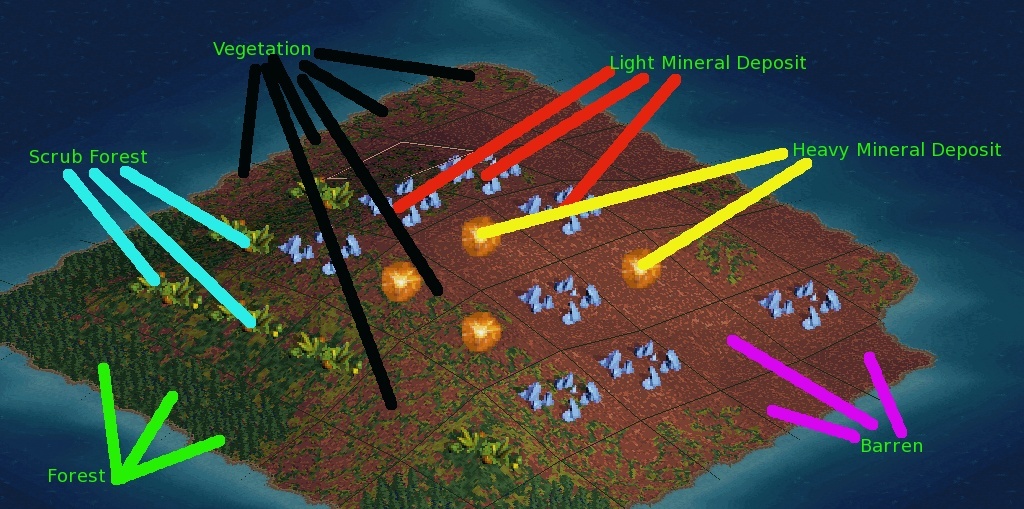Terrain Types
Page 1 of 1
 Terrain Types
Terrain Types
As you may have noticed, the map is divided into a grid. One of the most important functions of this grid is to help differentiate terrain by Types. Different Terrain types yield different resources when worked by your population.
On important thing to note is that at the beginning, only up to 2 population units can work any one square in the grid. Strongholds, and certain researched technologies, can increase this number, allowing you more production from a single square. See STRONGHOLDS, below, for more information.
All in all, there are about 7 types of Terrain that you'll need to worry about.

Light Mineral Deposits: These light mineral deposits are points where a relatively small amount of resources are available for extraction at any one time. However, in the absence of a heaver deposit, they are the soul source for resources that are vital to any economy.
Light Mineral deposits have 10 strata; the mineral contained in the first strata is revealed when the square with the deposit is initially terraformed.
Production: 1 Unit of minerals / 2 assigned Population units OR 2 units stone /2 assigned population units.
Heavy Mineral Deposits: These deposits are much richer in mineral resources, and contain not only a wider variety of resources, but also they are easier to extract than from a lighter deposit.
Heavy Mineral Deposits have 20 Strata: the minerals contained in the first 2 strata are revealed when the square with the deposit is initially terraformed.
Production: 2 Units of minerals/ 2 assigned population units OR 4 units stone /2 assigned population units.
On important thing to note is that at the beginning, only up to 2 population units can work any one square in the grid. Strongholds, and certain researched technologies, can increase this number, allowing you more production from a single square. See STRONGHOLDS, below, for more information.
All in all, there are about 7 types of Terrain that you'll need to worry about.

- Vegetation: Represented by the little patches of green spread all about the place, this terrain is populated by the planet's native flora, a bunch of hardy little plants that are capable of sustaining human life. They are relatively easy to find, so feeding your population is simply a matter of having the people work.
Production: 4 Units of food / 1 assigned Population unit
NOTE: Vegetation is particularly widespread, and may be observed under certain other resources, e.g. Mineral deposits. You may opt to harvest those squares as vegetation instead of their primary terrain type, but you will only receive 2 units of food per population unit, as the land is not particularly suited to agriculture. - Forests: Comprised of the planets native megaflora, these massive plants possess hard stems that make them a suitable analog for Earth's trees, the primary upshoot being that they are a prime source of carbon.
Production: 4 Units of carbon / 1 assigned Population unit - Scrub Forests: It appears that, above a certain altitude, the native forests are unable to sustain themselves. However, smaller, struggling versions of them manage to stay alive. Unfortunately, these small things are unsuitable for providing carbon, but do add some variety to the diet.
Production: 4 Units of food / 1 assigned Population unit - Seas: The Seas of planet are all freshwater... technically. In reality, the abundant free-floating iron has made its way into the sea in large amounts. While this is relatively easy for basic filtration to remove, it does have an interesting effect on the native wildlife. Still, carapaces as hard as iron are no match for human power tools, and a fairly wide variety of tasty arthropods can be extracted from seas to complement the human diet.
Production: 3 Units of food / 1 assigned Population unit - Barren: Barren landscape is landscape that has been terraformed, and yet is neither rich in material resources, nor has the correct conditions to support the planet's flora. This landscape is ripe with potential, however, as terraformation may eventually allow this otherwise pointless landscape to become useful.
- Mineral Deposits: Mineral deposits may carry a large variety of resources, depending on their position, volcanic activity in the area, and a little bit of random chance. These deposits are comprised of minerals that have risen up out of the crust due to tectonic activity: This is quite fortunate, as all scans have pointed to the crust of this planet being tougher than nearly anything encountered in Sol. Mineral deposits come with some special rules:
- Strata: Mineral deposits have strata: in simple terms, this means that typically one 'layer' of the deposit will be comprised of one general type of mineral resource. Determining the contents of a lower strata will require a Survey action: see GENERIC ACTIONS, above, for more details.
- Non-Renewable: Mineral deposits on planet, much like anywhere else in the universe, are not infinite: a given strata only contains so much of a mineral to be mined out. Once its gone, its gone. However, stone may always be mined from a mineral deposit, even if all its strata are empty.
Light Mineral deposits have 10 strata; the mineral contained in the first strata is revealed when the square with the deposit is initially terraformed.
Production: 1 Unit of minerals / 2 assigned Population units OR 2 units stone /2 assigned population units.
Heavy Mineral Deposits have 20 Strata: the minerals contained in the first 2 strata are revealed when the square with the deposit is initially terraformed.
Production: 2 Units of minerals/ 2 assigned population units OR 4 units stone /2 assigned population units.
Siggmund- Posts : 179
Join date : 2009-03-26
Page 1 of 1
Permissions in this forum:
You cannot reply to topics in this forum|
|
|
